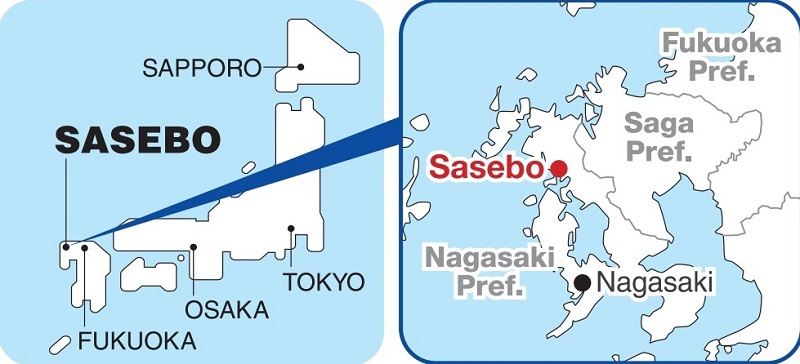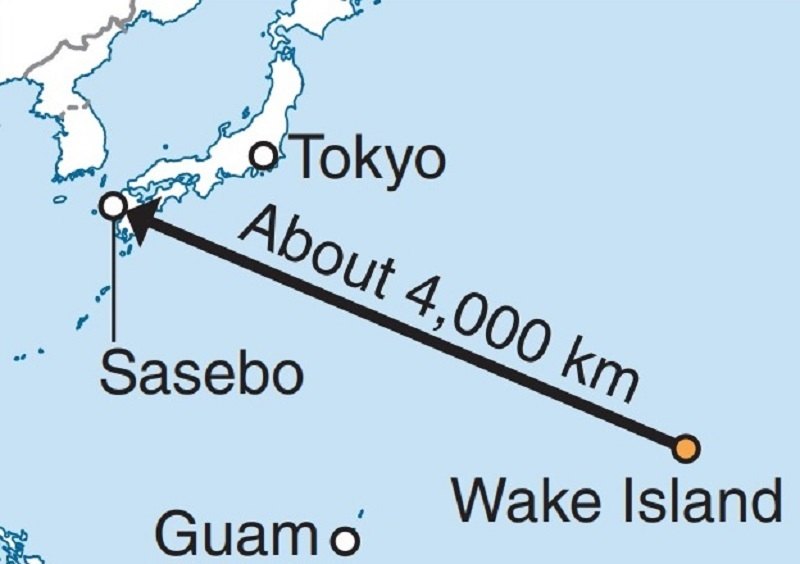Nagasaki: Film remembers U.S. POWs sacrificed for dam

Moto Nozawa, left, interviews an American sailor after a memorial ceremony held near the Soto Dam in Sasebo, Nagasaki Prefecture, on May 26.
10:51 JST, September 3, 2022
SASEBO, Nagasaki — A high school student has made a documentary about the history of a local dam, hoping to help people learn about the tragic deaths of American prisoners of war engaged in its construction.
Fifty-three American POWs died under harsh labor conditions while building the Soto Dam in Sasebo, Nagasaki Prefecture, during World War II.
The dam continues to operate 78 years after its completion as a reservoir for drinking water for local residents.
With an urge to know more about the tragedy, Moto Nozawa, a 17-year-old student at Sasebo Nishi High School, collected relevant documents and conducted interviews to create a film highlighting the misery of war.
Japan also a perpetrator

“I don’t want to talk about the war only from a victim’s viewpoint. I want people to know the history, that Japan also did terrible things,” said Nozawa at a peace education lecture held at a junior high school in the city on July 19.
As an invited speaker, Nozawa introduced his work and talked about why he produced the film in front of students at the school located near the dam.
According to the city’s records and other documents, the dam is 34 meters high, 150 meters wide and has a water storage capacity of 400,000 tons.
Its construction was launched in February 1941 by the Imperial Japanese Navy to use water from the Muta River for naval facilities and ships.
When the Pacific War broke out in December, concrete and other materials, as well as labor, were soon in short supply. A total of 250 American POWs were mobilized from Wake Island, a U.S. island in the Pacific Ocean occupied by Japan, to build the reservoir. They were given identification numbers, according to records.
Although the dam was completed in July 1944, 53 died as a result of hard labor and a dangerous work environment due to the work being rushed.
The bodies of the POWs who died during the construction were buried north of the water source. After the end of the war, U.S. soldiers dug up the remains and returned them to their homeland. In 1956, a cenotaph inscribed with their names was also erected on the bank of the dam.
Nozawa, who belongs to the school’s broadcasting club, first became interested in the history of the dam around November last year when he came across a picture of the cenotaph at a shop promoting local specialties. He felt the urge to “research not only the damage caused by the atomic bombings but also the fact that Japan was the perpetrator of the war” and began going to a library to trace the history through local records and other sources.
With the help of an American living in the area, Nozawa also obtained materials from the U.S. National Archives and Records Administration (NARA). He also covered a memorial ceremony held at the dam in May.
The eight-minute film was completed in June. It contains materials from NARA, including photos of the dam when it was under construction and the burial pits for the deceased POWs. It also features an interview with a person working at the U.S. Navy base in the city. This person called for more people to be aware of the countless important stories that exist locally and to learn lessons from the past.
Nozawa decided to call the film “Beside You” to reflect the message that “important history can be hidden behind the things we use in everyday life.”
The documentary won a prefectural contest for broadcast works created by high school students for its extensive coverage of the U.S. military. Nozawa has also received requests from the Nagasaki Prefectural Library and other entities to provide them with his film.
“Through the history of the dam, I want to convey to a wide audience the reality of war, which drags many people into tragedy,” said Nozawa.
Wake Island

The Pacific island, a U.S. territory since 1899, is about 4,000 kilometers southeast of Sasebo. It had a base for the U.S. Navy and was occupied by Japan during the Pacific War.
"Features" POPULAR ARTICLE
JN ACCESS RANKING





